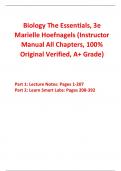Exam (elaborations)
Instructor's Manual for Biology The Essentials 3rd Edition By Marielle Hoefnagels (All Chapters, 100% Original Verified, A+ Grade)
Course
Biology The Essentials 3rd
Institution
Biology The Essentials 3rd
This Is Original 3rd Edition of Instructor Manual From Original Author. All Other Files in the market are fake/old Edition. Other Sellers Have changed old Edition Number to new But Instructor Manual is old Edition.
Instructor's Manual for Biology The Essentials 3rd Edition By Marielle Hoefnagels...
[Show more]
Preview 4 out of 392 pages
Uploaded on
August 2, 2024
Number of pages
392
Written in
2024/2025
Type
Exam (elaborations)
Contains
Questions & answers
test bank exam bank mcqs solutions manual
test bank download free test bank download
free solutions manual answer key download
Institution
Biology The Essentials 3rd
Course
Biology The Essentials 3rd
$16.49
100% satisfaction guarantee
Immediately available after payment
Both online and in PDF
No strings attached
Biology The Essentials, 3e Marielle Hoefnagels (Instructor Manual All Chapters, 100% Original Verified, A+ Grade)




